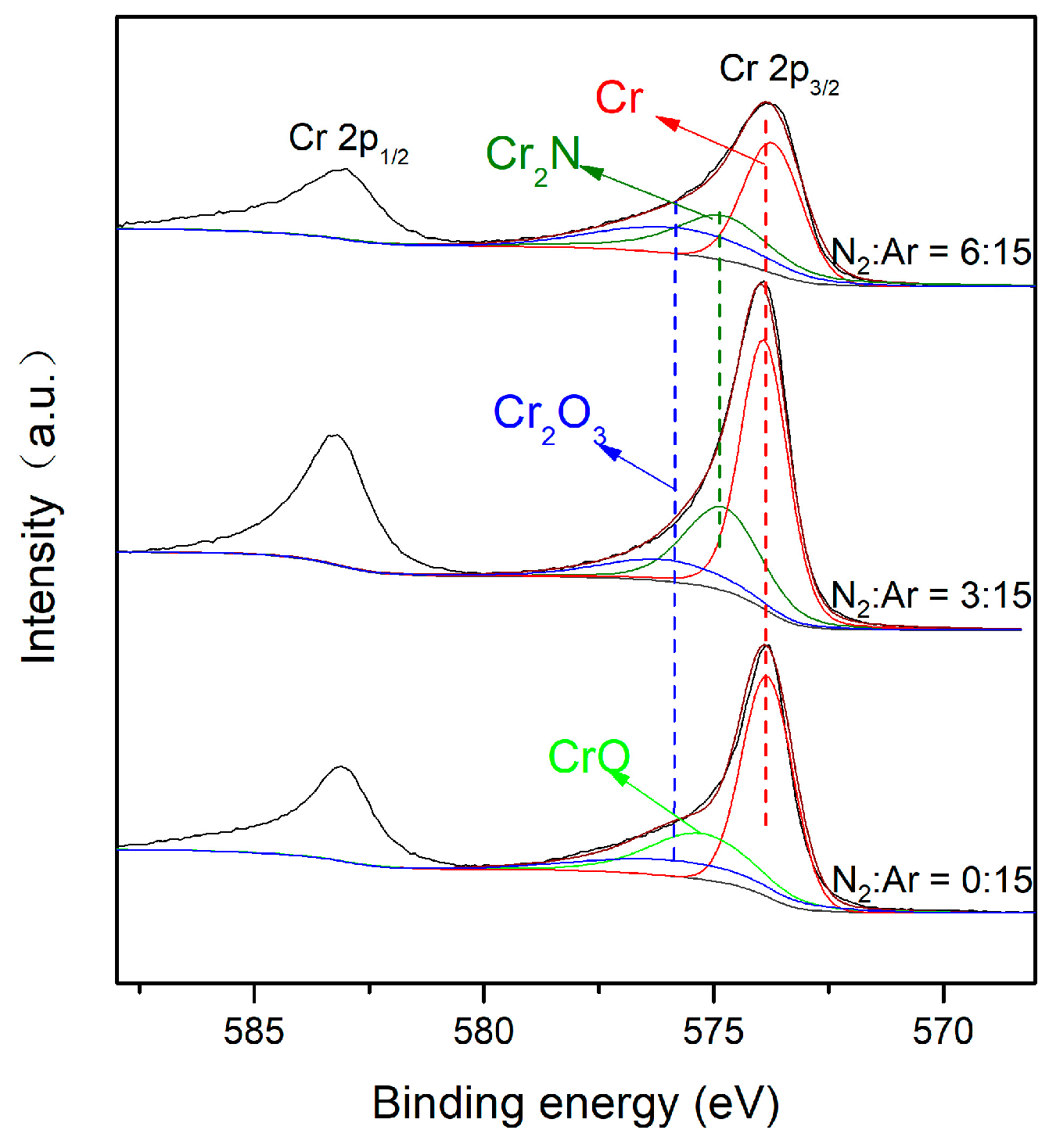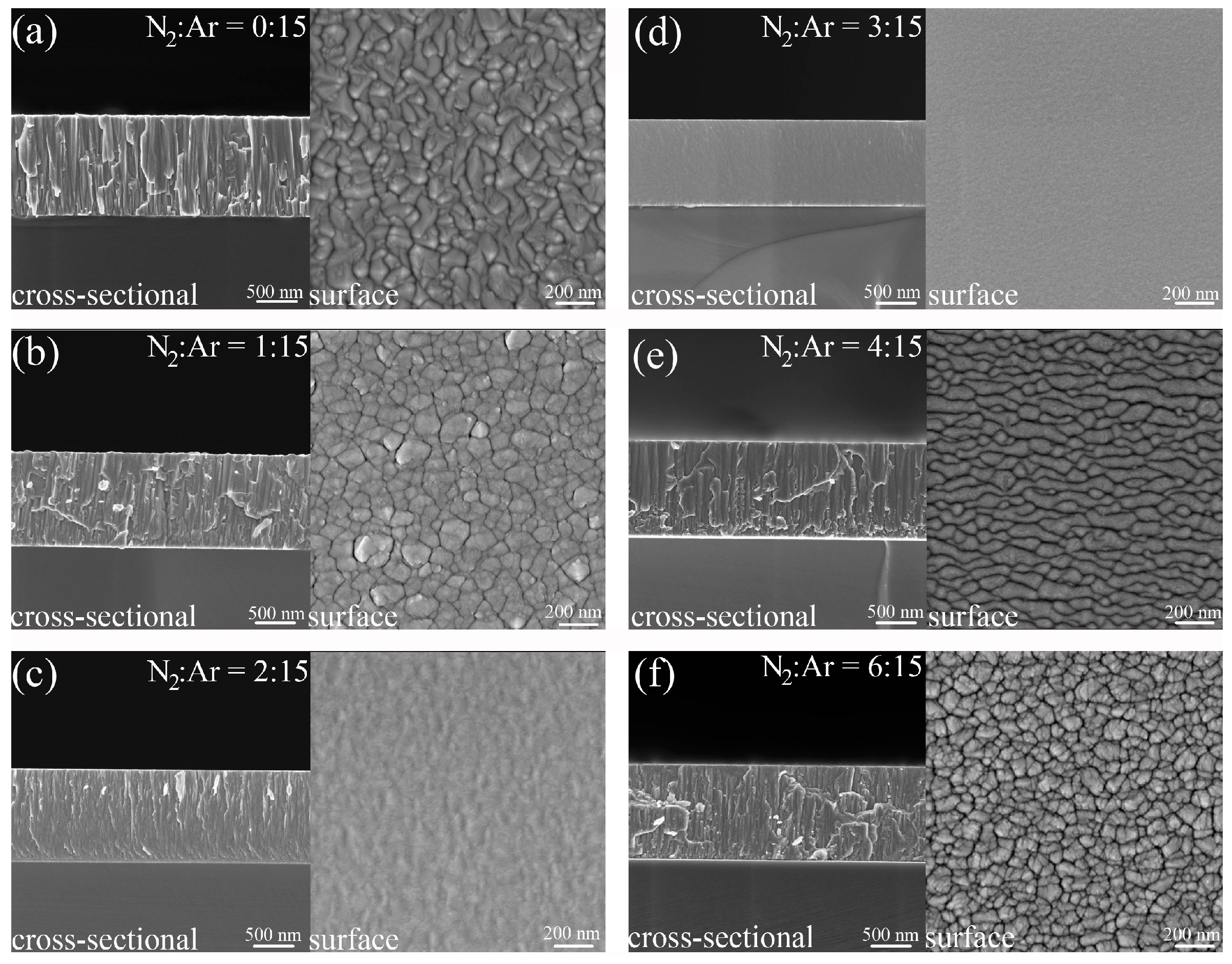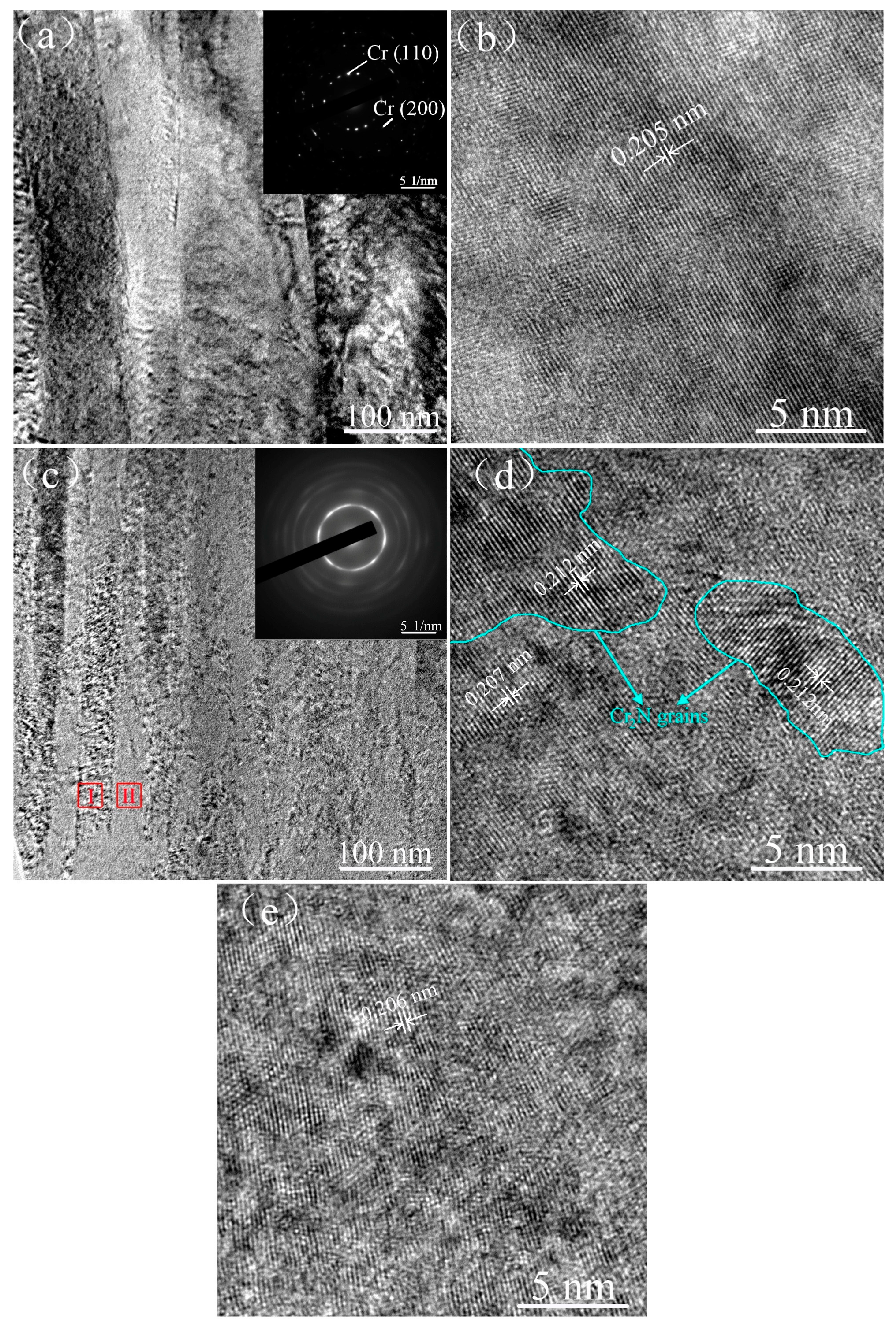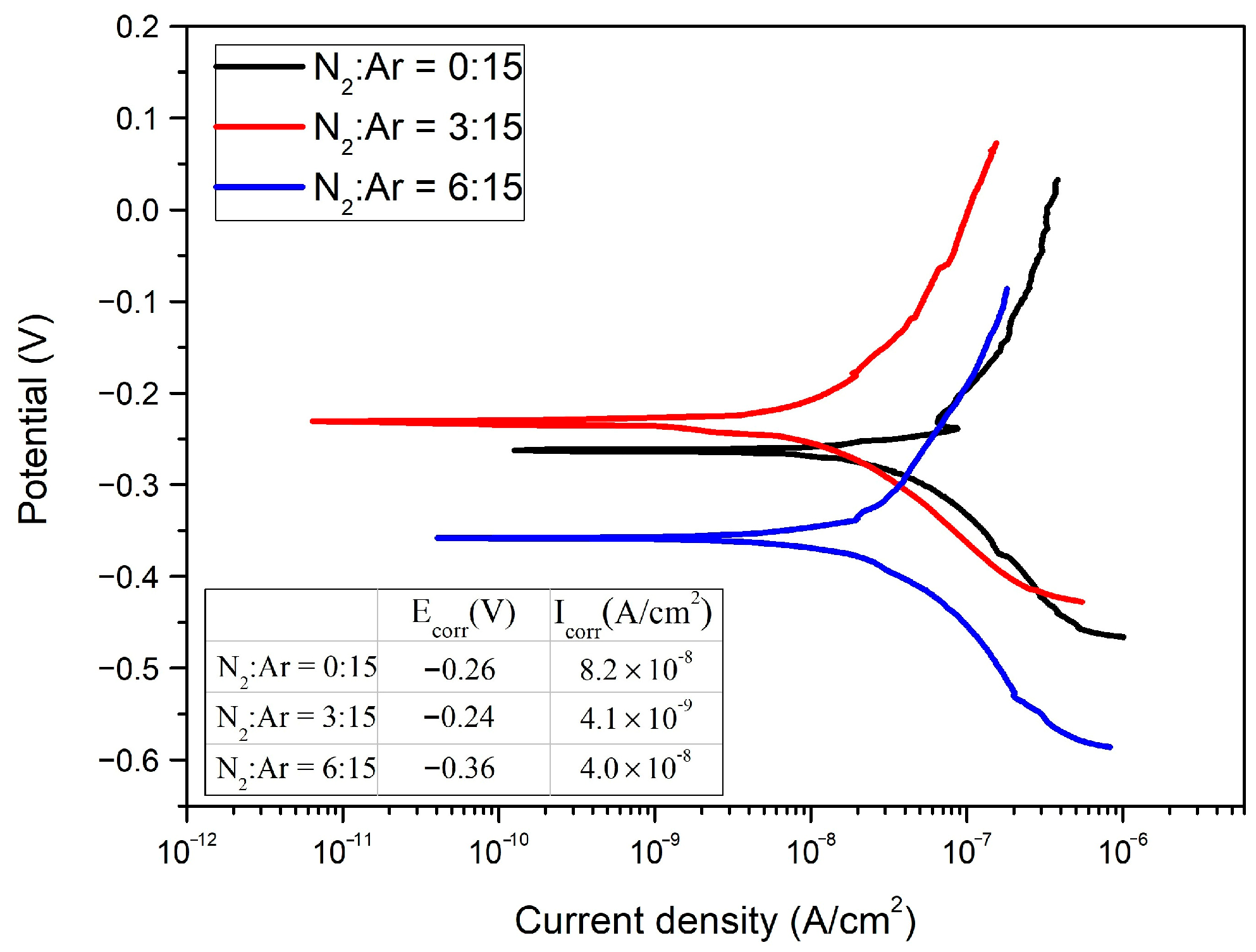Microstructure, Mechanical and Corrosion Properties of Column-Free CrNx Coatings Deposited by Closed Field Unbalanced Magnetron Sputtering
Abstract
:1. Introduction
2. Experimental Details
3. Results and Discussion
4. Conclusions
Author Contributions
Funding
Institutional Review Board Statement
Informed Consent Statement
Data Availability Statement
Conflicts of Interest
References
- Tabrizi, A.T.; Aghajani, H. Study through Diverse Synthesis Methods of Chromium Nitride Thin Layers: A Review. J. Surf. Investig. X-ray 2021, 15, 1217–1224. [Google Scholar] [CrossRef]
- Fenker, M.; Balzer, M.; Kappl, H. Corrosion protection with hard coatings on steel: Past approaches and current research efforts. Surf. Coat. Technol. 2014, 257, 182–205. [Google Scholar] [CrossRef]
- Kashkarov, E.B.; Obrosov, A.; Sutygina, A.N.; Uludintceva, E.; Mitrofanov, A.; Weiß, S. Hydrogen Permeation, and Mechanical and Tribological Behavior, of CrNx Coatings Deposited at Various Bias Voltages on IN718 by Direct Current Reactive Sputtering. Coatings 2018, 8, 66. [Google Scholar] [CrossRef]
- Shan, L.; Wang, Y.; Li, J.; Chen, J. Effect of N2 flow rate on microstructure and mechanical properties of PVD CrNx coatings for tribological application in seawater. Surf. Coat. Technol. 2014, 242, 74–82. [Google Scholar] [CrossRef]
- Tabrizi, A.T.; Aghajan, H.; Laleh, F.F. Tribological characterization of hybrid chromium nitride thin layer synthesized on titanium. Surf. Coat. Technol. 2021, 419, 127317. [Google Scholar] [CrossRef]
- Forniés, E.; Galindo, R.E.; Sánchez, O.; Albella, J.M. Growth of CrNx films by DC reactive magnetron sputtering at constant N2/Ar gas flow. Surf. Coat. Technol. 2006, 200, 6047–6053. [Google Scholar] [CrossRef]
- Zhang, G.A.; Yan, P.X.; Wang, P.; Chen, Y.M.; Zhang, J.Y. Influence of nitrogen content on the structural, electrical and mechanical properties of CrNx thin films. Mat. Sci. Eng. A 2007, 460, 301–305. [Google Scholar] [CrossRef]
- Qi, A.; Wu, Z.; Zhang, D.; Wang, J.; Wang, Z. Effect of sputtering power on the chemical composition, microstructure and mechanical properties of CrNx hard coatings deposited by reactive magnetron sputtering. Vacuum 2017, 145, 136–143. [Google Scholar] [CrossRef]
- Lin, J.; Wu, Z.L.; Zhang, X.H.; Mishra, B.; Moore, J.J.; Sproul, W.D. A comparative study of CrNx coatings synthesized by dc and pulsed dc magnetron sputtering. Thin Solid Film. 2009, 517, 1887–1894. [Google Scholar] [CrossRef]
- Zhang, D.; Zuo, X.; Wang, Z.; Li, H.; Chen, R.; Wang, A.; Ke, P. Comparative study on protective properties of CrN coatings on the ABS substrate by DCMS and HiPIMS techniques. Surf. Coat. Technol. 2020, 394, 125890. [Google Scholar] [CrossRef]
- Ruden, A.; Restrepo-Parra, E.; Paladines, A.U.; Sequeda, F. Corrosion resistance of CrN thin films produced by dc magnetron sputtering. Appl. Surf. Sci. 2013, 270, 150–156. [Google Scholar] [CrossRef]
- Petrov, I.; Barna, P.B.; Hultman, L.; Greene, J.E. Microstructural evolution during film growth. J. Vac. Sci. Technol. A 2003, 21, S117–S128. [Google Scholar] [CrossRef]
- Hurkmans, T.; Lewis, D.B.; Paritong, H.; Brooks, J.S.; Münz, W.D. Influence of ion bombardment on structure and properties of unbalanced magnetron grown CrNx coatings. Surf. Coat. Technol. 1999, 114, 52–59. [Google Scholar] [CrossRef]
- Olay, J.J.; Rodil, S.E.; Muhl, S.; Sánchez, E. Comparative study of chromium nitride coatings deposited by unbalanced and balanced magnetron sputtering. Thin Solid Film. 2005, 474, 119–126. [Google Scholar] [CrossRef]
- Lin, J.; Sproul, W.D.; Moore, J.J.; Wu, Z.L.; Lee, S.L. Effect of negative substrate bias voltage on the structure and properties of CrN films deposited by modulated pulsed power (MPP) magnetron sputtering. J. Phys. D Appl. Phys. 2011, 44, 425305. [Google Scholar] [CrossRef]
- Lin, J.; Moore, J.J.; Sproul, W.D.; Mishra, B.; Wu, Z.L.; Wang, J. The structure and properties of chromium nitride coatings deposited using dc, pulsed dc and modulated pulse power magnetron sputtering. Surf. Coat. Technol. 2010, 204, 2230–2239. [Google Scholar] [CrossRef]
- Gui, B.; Zhou, H.; Liu, X.; Zhang, K.; Hu, H.; Yang, L.; Zhang, Y. Influence of N2 flow rate on microstructure and properties of CrNx ceramic films prepared by MPP technique at low temperature. Ceram. Int. 2021, 47, 20875–20884. [Google Scholar] [CrossRef]
- Greczynski, G.; Jensen, J.; Böhlmark, J.; Hultman, L. Microstructure control of CrNx films during high power impulse magnetron sputtering. Surf. Coat. Technol. 2010, 205, 118–130. [Google Scholar] [CrossRef]
- Greczynski, G.; Jensen, J.; Hultman, L. CrNx Films Prepared by DC Magnetron Sputtering and High-Power Pulsed Magnetron Sputtering: A Comparative Study. IEEE Trans. Plasma Sci. 2010, 38, 3046–3056. [Google Scholar] [CrossRef]
- Fu, L.S.; Dai, W.; Wang, Q.M.; Zeng, K. Microstructures and mechanical properties of CrN coatings deposited by HIPIMS. Mater. Sci. Forum 2016, 836, 234–241. [Google Scholar] [CrossRef]
- Greczynski, G.; Lu, J.; Tengstrand, O.; Petrov, I.; Greene, J.E.; Hultman, L. Nitrogen-doped bcc-Cr films: Combining ceramic hardness with metallic toughness and conductivity. Scripta Mater. 2016, 122, 40–44. [Google Scholar] [CrossRef]
- Ferreira, F.; Oliveira, J.C.; Cavaleiro, A. CrN thin films deposited by HiPIMS in DOMS mode. Surf. Coat. Technol. 2016, 291, 365–375. [Google Scholar] [CrossRef]
- Arnell, R.D.; Kelly, P.J. Recent advances in magnetron sputtering. Surf. Coat. Technol. 1999, 112, 170–176. [Google Scholar] [CrossRef]
- NIST Data Base. Available online: https://srdata.nist.gov/xps/ (accessed on 26 August 2022).
- Eriksson, M.; Sainio, J.; Lahtinen, J. Chromium deposition on ordered alumina films: An x-ray photoelectron spectroscopy study of the interaction with oxygen. J. Chem. Phys. 2002, 116, 3870–3874. [Google Scholar] [CrossRef]
- Kajikawa, Y.; Noda, S.; Komiyama, H. Comprehensive perspective on the mechanism of preferred orientation in reactive-sputter-deposited nitrides. J. Vac. Sci. Technol. A 2003, 21, 1943–1954. [Google Scholar] [CrossRef]
- Moelans, N.; Blanpain, B.; Wollants, P. Pinning effect of second-phase particles on grain growth in polycrystalline films studied by 3-D phase field simulations. Acta Mater. 2007, 55, 2173–2182. [Google Scholar] [CrossRef]
- McHale, A.E. Phase Equilibrium Diagrams-Borides, Carbides and Nitrides; The American Ceramic Society: Westerville, OH, USA, 1994; Volume X, p. 451. [Google Scholar]
- Matthews, A.; Franklin, S.; Holmberg, K. Tribological coatings: Contact mechanisms and selection. J. Phy. D Appl. Phy. 2007, 40, 5463. [Google Scholar] [CrossRef]
- Chen, X.; Du, Y.; Chung, Y.W. Commentary on using H/E and H3/E2 as proxies for fracture toughness of hard coatings. Thin Solid Film. 2019, 688, 137265. [Google Scholar] [CrossRef]
- Lansdell, P.A.W.; Farr, J.P.G. A comparison of the surface chemistries of chromium electroplated finishes. Trans. IMF 2004, 82, 105–113. [Google Scholar] [CrossRef]
- Wang, L.; Wang, M.; Chen, H. Corrosion mechanism investigation of TiAlN/CrN superlattice coating by multi-arc ion plating in 3.5 wt% NaCl solution. Surf. Coat. Technol. 2020, 391, 125660. [Google Scholar] [CrossRef]
- Imaz, N.; Ostra, M.; Vidal, M.; Díez, J.A.; Sarret, M.; García-Lecina, E. Corrosion behaviour of chromium coatings obtained by direct and reverse pulse plating electrodeposition in NaCl aqueous solution. Corros. Sci. 2014, 78, 251–259. [Google Scholar] [CrossRef]






| Sample ID | N2:Ar Flow Ratio | Chemical Composition (at.%) | Coating Thickness (μm) | H/E | H3/E*2 | |
|---|---|---|---|---|---|---|
| Cr | N | |||||
| Cr | 0:15 | 100 | - | 1.32 | 0.042 | 0.019 |
| CN-1 | 1:15 | 95.9 | 4.1 | 1.22 | 0.053 | 0.039 |
| CN-2 | 2:15 | 91.4 | 8.6 | 1.25 | 0.076 | 0.122 |
| CN-3 | 3:15 | 85.2 | 14.8 | 1.13 | 0.095 | 0.254 |
| CN-4 | 4:15 | 78.8 | 21.2 | 1.26 | 0.081 | 0.141 |
| CN-6 | 6:15 | 62.3 | 31.7 | 1.24 | 0.088 | 0.197 |
Publisher’s Note: MDPI stays neutral with regard to jurisdictional claims in published maps and institutional affiliations. |
© 2022 by the authors. Licensee MDPI, Basel, Switzerland. This article is an open access article distributed under the terms and conditions of the Creative Commons Attribution (CC BY) license (https://creativecommons.org/licenses/by/4.0/).
Share and Cite
Wang, T.; Wang, Y.; Cheng, Q.; Yu, S.; Zhang, G. Microstructure, Mechanical and Corrosion Properties of Column-Free CrNx Coatings Deposited by Closed Field Unbalanced Magnetron Sputtering. Coatings 2022, 12, 1327. https://doi.org/10.3390/coatings12091327
Wang T, Wang Y, Cheng Q, Yu S, Zhang G. Microstructure, Mechanical and Corrosion Properties of Column-Free CrNx Coatings Deposited by Closed Field Unbalanced Magnetron Sputtering. Coatings. 2022; 12(9):1327. https://doi.org/10.3390/coatings12091327
Chicago/Turabian StyleWang, Tao, Yifan Wang, Qi Cheng, Shouming Yu, and Guojun Zhang. 2022. "Microstructure, Mechanical and Corrosion Properties of Column-Free CrNx Coatings Deposited by Closed Field Unbalanced Magnetron Sputtering" Coatings 12, no. 9: 1327. https://doi.org/10.3390/coatings12091327




